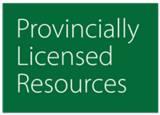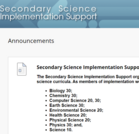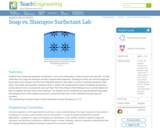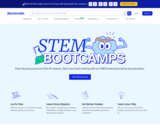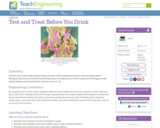« Sciences, on explore! Vous propose de petites expériences pour découvrir les sciences!
« 35 expériences accompagnées de courtes vidéos et de fiches explicatives destinées au personnel enseignant. »
Expériences:
-Un sens d'équilibre inégalé (structures, forces, mécanismes)
-Un pendule coinceur (forces et mouvement, cinématique)
-Le secret de la couche jetable (matière et énergie, fluides, réactions chimiques)
-Conçois un circuit
-Un bolide de course (forces et mouvement, énergie potentielle élastique)
-Un ballon criard (énergie cinétique, le son)
-La boisson gazeuse invisible (mélanges, réactions chimiques)
-Un extincteur au dioxyde de carbone (fluides, réactions chimiques)
-La machine à bruit (son)
-Des ustensiles en équilibre (structures, mécanismes, forces)
-Un sifflet tout simple (son, fluides, ondes sonores)
-L'éclatement énigmatique d'un ballon (lumière et son, chaleur, optique)
-Le ballon-fakir (forces, mécanismes, énergie mécanique)
-Des poumons artificiels (êtres vivants, systèmes du corps humain cellule, anatomie)
-De la fécule de maïs électrique (forces, électricité, atomes)
-Une bouteille trouée (matière, forces, vol, mécanismes, fluides, systèmes hydrauliques)
-Des pièces de monnaie multicolores (matière, mélanges, réactions chimiques)
-Un nuage dans une bouteille (air et eau, matière, substances pures, fluides, systèmes hydrographiques, changements climatiques, environnement)
-Une pile fruitée (électricité)
-Des courants de convection multicolores (liquides, chaleur, mélanges, fluides, systèmes hydrographiques, changements climatiques, énergie thermique)
-Incroyable colonne multicouche (liquides, mélanges, fluides, systèmes hydrographiques)
-Des œillets multicolores (êtres vivants, plantes, biodiversité, biologie, anatomie)
-Une catapulte toute simple (forces, mécanismes, structures, cinématique)
-Des pipettes submersibles (fluides, mécanismes, forces, systèmes hydrauliques, dynamique)
-La balle de tennis de table volante (forces, vol, systèmes pneumatiques)
-Un œuf gonflé ou ratatiné (cellule, systèmes animaux, réactions chimiques)
-Un kaléidoscope maison (lumière, optique)
-Un anneau inertiel (forces, mécanismes, énergie mécanique, dynamique)
-Les livres indissociables (forces, mécanismes, réactions chimiques, chimie organique)
-L’absorption de déversements de pétrole (mélanges, fluides, systèmes hydrographiques, réactions chimiques, chimie organique)
-Un four solaire à s’mores (lumière, matière, énergie, chaleur, changements climatiques, environnement)
-Le tissu photosensible (matière, chaleur, lumière, optique, changements climatiques)
-Le pouvoir de l’air (air et eau, forces, vol, systèmes pneumatiques)
-Un thermomètre artisanal (air et eau, chaleur, environnement, fluides)
-Pourquoi l’eau monte-t-elle? (matière, mélanges, chaleur, changements climatiques)



